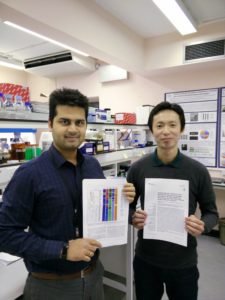New publication in Frontiers in Microbiology

I am happy to announce that my first-authored original research article was published at the end of 2017 in Frontiers in Microbiology entitled: Probing genomic aspects of the multi-host pathogen Clostridium perfringens reveals significant pangenome diversity, and a diverse array of virulence factors.
This study primarily explores the genetic makeup of the well-known gut pathogen C. perfringens, which is also known to be the causative agent of gas gangrene. In particular we probed the ‘pangenome’, that is the collection of genes in multiple closely-related bacterial strains, and also relevant disease-causing factors, such as toxins. The idea for this study happened in a coffee break, when myself and Shab (bioinformatician in Hall lab, we are both joint-first authors in this work) were chatting about this pathogen and realised that although C. perfringens is a known pathogen to human and animals, and this species secretes >20 toxins (most prolific toxin-producing bacteria ever known), the overall genomic information of this bacterium is very limited, which is a real bottle neck for understanding how this pathogen causes disease. To put this into perspective, only 51 C. perfringens genomes were sequenced and publicly available at the time of our analysis, which is a small number when compared to other related gut pathogens such as C. difficile, which has over >1000 sequenced genomes. Therefore, this present genomic study of C. perfringens, represents the largest of its kind, comprising 56 genomes (previous published studies examined a maximum of 12 genomes), and is important as the data and conclusions generated provides critical information about this infectious, and potentially deadly agent.
Computational i.e. bioinformatics analysis on these 56 genomes (including 5 novel genomes) revealed that C. perfringens has a surprisingly ‘open’ pangenome, with only 12.6% core genes identified, which means this is currently the most divergent Gram-positive bacterial pangenome described (only E. coli may surpass this number). This high degree of diversity implies the highly adaptable nature of this pathogen, which is found in diverse environment, and suggests it can readily ‘take-up’ external pieces of DNA, that may encode genes that are useful to its survival. Our findings also suggest that a common trait in this pathogen is the carriage of genes that provide resistance to tetracycline (a widely used antibiotic), 75% of the strains sequenced possess these resistance genes, which indicates that this antibiotic may be ineffective for treatment of infection. Interestingly, there was a major absence of CRISPR arrays, which are a defensive system against viral invasion and integration of their DNA into bacteria, and alongside the presence of viral genomes, indicates that viruses could potentially be the driving factor for the evolution and virulence of this multi-host pathogen.
I have learnt a lot, through performing lots of different types of bioinformatics analysis, interpreting data, and writing up this paper. For this I would like to say a big THANK YOU to all the co-authors involved in this work, without whom this study is an impossible task!
Kiu, R., Caim, S., Alexander, S., Pachori, P. & Hall, L. J. Probing Genomic Aspects of the Multi-Host Pathogen Clostridium perfringens Reveals Significant Pangenome Diversity, and a Diverse Array of Virulence Factors. Front Microbiol 8, 2485, https://doi.org/10.3389/fmicb.2017.02485 (2017).





